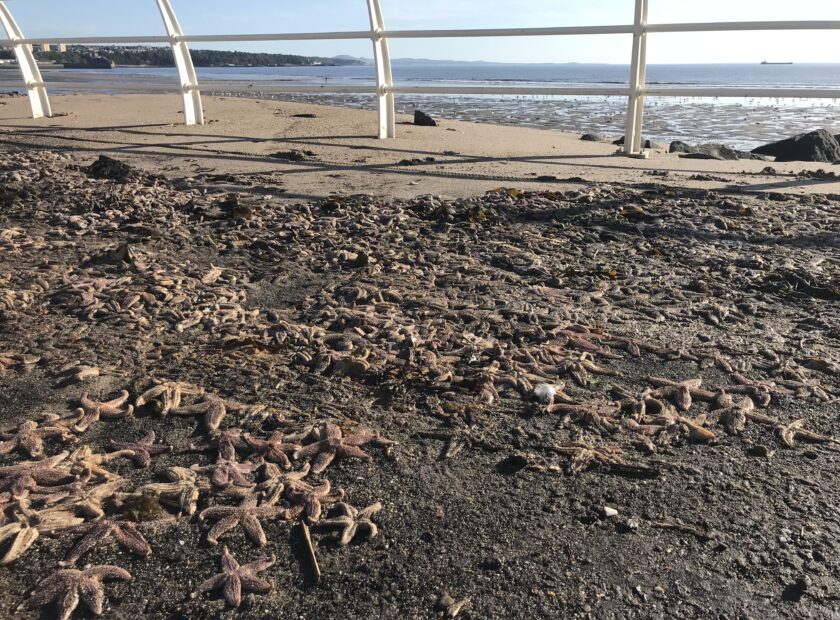Thousands of starfish on Kirkcaldy Beach – why did it happen and what can we do?

All along the beachfront of Kirkcaldy last week, thousands of starfish washed up on the shore, as well as on the promenade walkway near the Basin car park.
This sight was shocking and troubling to many people – but why did it happen?
What happened and what it means
There are a few possible reasons. The most likely explanation is the recent storms and adverse weather conditions, which are becoming more pressing and prevalent due to the climate crisis.
A BBC news article quotes Fife Coast and Countryside Trust saying that “strong onshore winds could have led to the stranding.”
This is a fair assumption as starfish are particularly vulnerable during strong currents due to their shape. After storms, when food is more abundant, starfish tend to group together. They may also have been “Starballing” – a relatively recent discovery in starfish behaviour.
When dislodged from the seabed or under stress, starfish curl themselves into a ball-like shape. Presumably for protection but is also possibly a voluntary mode of transport as they are a slow-moving creature. Unfortunately, this can make them even more vulnerable to mass strandings under the wrong conditions.
In a 2016 article for Plymouth University Andrew Merrington described research from the ‘Panache Project’. He states: “The scientists found that as the tidal flow increased to 0.5 metres per second, the starfish were rolling over the seabed with the arms curled into a ball.”
This time of year roughly falls just after their spawning season, which could explain why so many were affected.
Why did so few starfish survive?
Starfish cannot survive outside of water for more than a few minutes because of how they breathe. Their bodies are covered in tiny bumps called papulae – like gills – that diffuse oxygen directly from the water. Without water flowing over them, they die very quickly.
Tragically, mass strandings like this are not unusual. In Nairn in 2021 (after Storm Arwen) and in West Norfolk in 2018 (after Storm Emma), there were also huge numbers of starfish washed ashore. With weather patterns becoming increasingly unstable due to climate change, these events may become more common.
By understanding why these strandings occur, we can better grasp the vulnerable state of marine life on our doorstep – and consider what we can do to protect it.
What we can do locally
The Fife coastline is one of our greatest treasures, but it depends on us to keep it healthy.
Here are some ways we can all help:
-
Join a beach clean – Even an hour with a litter picker makes a big difference for wildlife and the community.
-
Reduce single-use plastics – Choose reusable bottles, bags, etc. to cut down what might end up in the sea.
-
Be mindful of drains – Everything that washes down the street can reach the ocean. Avoid pouring oils or chemicals down the sink, and never flush wipes down the toilet.
-
Support local marine projects – Get involved with local groups to help campaign and raise awareness.
-
Respect marine life – When exploring rockpools or beaches, look but don’t disturb. Small actions protect delicate ecosystems.
Together, we can ensure that the Fife coastline remains a haven for its ecosystems while staying a place of beauty for future generations.
Get involved
The Marine Conservation Society have lots of great resources and can point you in the right direction for citizen science research and beach cleans taking place near you.
Here in Fife from 20th September – 19th October you can take part in Fife Climate Festival. There are lots of events to get involved in, many of which give you the opportunity to make a difference locally to help fight the climate emergency. Fife Climate Festival is led by Fife Climate Hub with support from Climate Action Fife, and funded by the Scottish Government and the National Lottery Community Fund
Rachel Donachie
Greener Kirkcaldy Media Volunteer
|